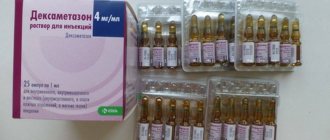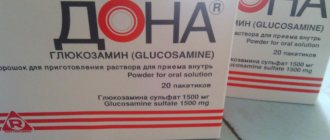Instructions for use DIAZEPAM solution
In emergency situations, diazepam is recommended to be administered intravenously. IM administration of diazepam is indicated for premedication. The dosage regimen and duration of treatment should be selected individually, depending on the condition and response of the patient, the clinical picture of the disease, sensitivity to the drug, and strictly as prescribed by the doctor.
The best method for selecting a dose individually for each patient is an initial administration of 5 mg (1 ml), followed by repeated administration of 2.5 mg (0.5 ml). After each additional injection of 2.5 mg for 30 seconds, it is necessary to monitor the patient's reaction. Doses above 0.35 mg/kg body weight should not be administered.
Adults are usually prescribed:
2-20 mg IM or IV, depending on the indications and severity of the disease. In some cases, an increase in dose is required (tetanus). In severe conditions, injections can be repeated over 1 hour, although the recommended interval between doses is 3-4 hours.
Attention!
Elderly and senile patients, as well as weakened or exhausted patients, are recommended to start with half the usual adult dose, gradually increasing it, depending on the effect achieved and tolerability. Parenterally, in case of anxiety, administer intravenously at an initial dose of 0.1-0.2 mg/kg body weight, injections are repeated every 8 hours until symptoms disappear, then switch to oral administration.
Patients with renal and hepatic insufficiency require a dose reduction.
Psychiatry.
For psychomotor agitation and anxiety, adults are prescribed Iazepam intramuscularly, for severe symptoms - intravenous (in exceptional cases, a single dose can reach 30 mg), then 10 mg 3-4 times a day.
In case of acute anxiety and restlessness, 2-5 mg IM or IV is prescribed, if necessary, the dose is repeated after 3-4 hours.
For severe phobic disorders, up to 5-10 mg IM or IV is prescribed; if necessary, the dose is repeated after 3-4 hours.
For withdrawal syndrome in alcoholics (to alleviate symptoms of acute agitation, muscle tremors, threatening or acute delirium), first 10 mg IM, and if necessary, after 3-4 hours, again 5-10 mg. If necessary, the first dose is administered intravenously.
Neurology.
For status epilepticus and frequently recurring seizures, therapy begins with intravenous administration (if intravenous administration of the drug is not possible, intramuscular administration) of diazepam to adults at a dose of initially 5-10 mg. The intravenous injection can be repeated if necessary (with special care) first after 1/2-1 hour, then after 4 hours, up to a maximum of 30 mg. After the seizures stop or their frequency decreases, they switch to intramuscular administration of the drug every 4-6 hours (adults at a dose of 10 mg, children - 5 mg) for several days. In case of rapid cessation of seizures, a prophylactic dose of the drug 10 mg is administered intramuscularly, immediately after intravenous injection. Patients with chronic lung diseases and circulatory failure require special attention. In severe forms of status epilepticus, up to 100 mg/day can be administered dropwise.
Muscle spasm of central origin.
In degenerative neurological diseases, spinal cord injuries, which are accompanied by spastic paraplegia or hemiplegia, choreoid disorders:
- initially 10 - 20 mg IM or slowly IV (children 2-10 mg), then treatment with an oral dosage form.
Muscle spasm of peripheral origin (for example, lumbago, brachialgia), 1-2 times a day, 10-20 mg IM. After relief of acute symptoms, oral treatment is continued (5 mg 1-4 times a day).
For tetanus, athetosis, muscle spasms against the background of local pathology, treatment begins with 5-10 mg IM or IV. When treating tetanus, it may be necessary to increase the dose.
Anesthesiology, surgery.
Before diagnostic procedures, for example, endoscopy, if the patient has severe anxiety or a stress reaction, a slow IV administration of 10 mg is recommended, up to a maximum of 20 mg of the drug, provided that the patient is not simultaneously receiving narcotic painkillers. If intravenous administration of the medication is difficult, it is necessary to administer 5-10 mg intramuscularly over 30 minutes. before the procedure.
Preoperative premedication: to eliminate anxiety, fear and tension, administer 10 mg intramuscularly 1 hour before surgery. To relieve spasms of skeletal muscles - 10 mg IM 1-2 hours before surgery
Introduction to Anesthesia:
- 0.2-0.5 mg/kg body weight slowly i.v. For short-term narcotic sleep during complex diagnostic and therapeutic interventions in therapy and surgery - intravenous adults - 10-30 mg; children - 0.1-0.2 mg/kg.
Premedication for cardioversion:
- 5-15 mg slowly IV (in portions) 5-10 minutes before the procedure.
Sedative protection (anterograde amnesia) during complex diagnostic and surgical interventions that require emotional stress (cardiac catheterization, endoscopy, radiological examinations, minor surgical interventions, reposition of dislocations and fractures, biopsy, changing dressings for burns, etc.):
- 10-30 mg slowly IV (children 0.1-0.2 mg/kg body weight).
As part of complex therapy for myocardial infarction: initial dose - 10 mg IM, then orally, 5-10 mg 1-3 times a day; premedication in case of defibrillation - 10-30 mg IV slowly (in separate doses);
Gynecology and obstetrics.
For use during pregnancy, an accurate diagnosis is a prerequisite.
Preeclampsia:
acute attack - 10-20 mg slowly intravenously, if necessary, the dose is repeated intravenously or a dropper is installed (up to 70 mg over 24 hours).
Eclampsia
- during a crisis - 10-20 mg IV, then, if necessary, IV stream or drip, no more than 100 mg/day.
With threatening premature birth and premature placental abruption
The initial dose is 10 mg and is administered intravenously, then the drug is administered at a dose of 10 or 20 mg intramuscularly for 3 days. In case of premature placental abruption, treatment is carried out without interruption - until the fetus matures.
Psychosomatic disorders, menopausal and menstrual disorders, gestosis - 2-5 mg 2-3 times a day.
Obstetrics.
When the uterus is dilated by 2-5 cm - 10-20 mg IM (with strong excitement, slow IV administration is possible).
Facilitation of gynecological interventions, suturing after episiotomy - 10 mg slowly IV.
For children.
In children, the dose for parenteral administration is determined individually depending on the condition, body weight, and age. For tetanus - children from 6 months to 5 years: 1-2 mg IM or IV (slowly), if necessary, repeat the dose after 3-4 hours. Children aged 5 years and older are prescribed 5-10 mg, if necessary, the dose is repeated after 3-4 hours.
For status epilepticus and severe, recurrent convulsive seizures, children from 2 to 5 years old are prescribed 0.2-0.5 mg IV slowly; if necessary, administration of the same dose can be repeated after 10-15 minutes, up to a maximum of 5 mg. Caution must be exercised, especially in young children, and administered intravenously very slowly to prevent respiratory impairment. Children aged 5 years and older are prescribed 1 mg over 2-5 minutes; if necessary, the same dose can be repeated after 10-15 minutes, up to a maximum of 10 mg. Intravenous administration (slow) is recommended. If necessary, repeat the dose after 2-4 hours.
Method of administration:
- IM injection:
the drug should be injected deeply into large muscles. - IV injection:
when administering IV, you should choose a large-caliber vein. Avoid intra-arterial administration. Administer slowly over at least 1 minute for every 5 mg (1 ml) of drug. Rapid administration can lead to a decrease in blood pressure, respiratory failure (possibly developing apnea) and even cardiac arrest. Diazepam injection solution should always be administered separately as it is incompatible with aqueous solutions of other medications. - intravenous drip infusion:
if necessary, intravenous drip injection (no more than 4 ml), the drug is diluted in a 5-10% dextrose solution or in a 0.9% sodium chloride solution. To avoid precipitation of the drug, use at least 250 ml of infusion solution and mix the resulting solution quickly and thoroughly. Sometimes after diluting the drug, cloudiness of the solution is observed, which disappears after a few minutes. If the cloudiness does not disappear, the drug is unsuitable for use. It is not recommended to carry out continuous intravenous infusions (precipitate formation and adsorption of the drug by polyvinyl chloride materials of infusion balloons and tubes are possible).
Effect on the body
The mechanism of action of diazepam is its stimulation of benzodiazepine receptors with simultaneous activation of GABA receptors and inhibition in synapses that regulate the emotional sphere, including the thalamus, hypothalamus, reticular formation and limbic system of the brain. Thanks to this effect, when using Diazepam, you can get several effects at once. Its ability to regulate the central nervous system gives the following results:
- Soothing. The sedative effect is to relieve anxiety and restlessness, reduce the body’s reactivity to external stimuli, and drowsiness. When using the drug in maximum quantities, inability to concentrate and absent-mindedness may occur. Overdose causes amnesia.
- Anxiolytic. A person’s anxiety level decreases, fears and tension go away.
- Hypnotic. Inhibiting arousal in the brain and eliminating excessive arousal helps a person normalize sleep and ensures falling asleep quickly.
- Anticonvulsant. The muscle relaxant effect of the substance blocks the conduction of impulses along interneurons located in the spinal cord. This allows you to stop seizures and reduce limb tremors.
The drug helps increase the pain threshold, reduces the need for peripheral tissues for oxygen, and eliminates syndromes caused by activation of the autonomic nervous system. All the main effects of Diazepam have a beneficial effect during the treatment of chronic alcoholism. It makes it much easier to survive the signs of withdrawal, stopping most of its symptoms. The medicine helps eliminate hand tremors, psychomotor agitation, anxiety, unmotivated aggression, convulsive syndrome, hallucinosis and reduces the severity of signs of alcoholic delirium.
Side effects
From the nervous system: at the beginning of treatment (especially in elderly patients) - drowsiness, dizziness, increased fatigue, decreased ability to concentrate, ataxia, disorientation, unsteady gait and poor coordination of movements, lethargy, dullness of emotions, slowed mental and motor reactions, anterograde amnesia (develops more often than when taking other benzodiazepines); rarely - headache, euphoria, depression, tremor, depressed mood, catalepsy, confusion, dystonic extrapyramidal reactions (uncontrolled body movements, including the eyes), weakness, myasthenia gravis during the day, hyporeflexia, dysarthria; extremely rarely - paradoxical reactions (aggressive outbursts, psychomotor agitation, fear, suicidal tendencies, muscle spasms, confusion, hallucinations, acute agitation, irritability, anxiety, insomnia). From the hematopoietic organs: leukopenia, neutropenia, agranulocytosis (chills, hyperthermia, sore throat, excessive fatigue or weakness), anemia, thrombocytopenia. From the digestive system: dry mouth or hypersalivation, heartburn, hiccups, gastralgia, nausea, vomiting, loss of appetite, constipation; liver dysfunction, increased activity of liver transaminases and alkaline phosphatase, jaundice. From the cardiovascular system: palpitations, tachycardia, decreased blood pressure (with parenteral administration). From the genitourinary system: urinary incontinence, urinary retention, renal dysfunction, increased or decreased libido, dysmenorrhea. Allergic reactions: skin rash, itching. Effect on the fetus: teratogenicity (especially the first trimester), central nervous system depression, respiratory impairment and suppression of the sucking reflex in newborns whose mothers used the drug. Local reactions: at the injection site - phlebitis or venous thrombosis (redness, swelling or pain at the injection site). Other: addiction, drug dependence; rarely - depression of the respiratory center, dysfunction of external respiration, visual impairment (diplopia), bulimia, weight loss. With a sharp reduction in dose or cessation of administration, a syndrome of “switching off” consciousness using induction doses occurs. May increase the toxicity of zidovudine. Rifampicin may increase the elimination of diazepam and reduce its plasma concentrations. Theophylline (used in low doses) may reduce or even reverse the sedative effect. Pharmaceutically incompatible in the same syringe with other drugs.
Indications
- Anxiety disorders.
— Dysphoria (as part of combination therapy as an additional drug).
— Insomnia (difficulty falling asleep).
— Spasm of skeletal muscles due to local injury;
- spastic conditions associated with damage to the brain or spinal cord (cerebral palsy, athetosis, tetanus);
- myositis, bursitis, arthritis, rheumatic pelvispondyloarthritis, progressive chronic polyarthritis;
- arthrosis, accompanied by tension in the skeletal muscles;
- vertebral syndrome, angina pectoris, tension headache.
— Alcohol withdrawal syndrome: anxiety, tension, agitation, tremor, transient reactive states.
— As part of complex therapy: arterial hypertension, peptic ulcer of the stomach and duodenum;
— psychosomatic disorders in obstetrics and gynecology: menopausal and menstrual disorders, gestosis;
- status epilepticus;
- eczema and other diseases accompanied by itching and irritability.
- Meniere's disease.
- Drug poisoning.
— Premedication before surgical interventions and endoscopic manipulations, general anesthesia.
For parenteral administration: premedication before general anesthesia;
— as a component of combined general anesthesia;
— myocardial infarction (as part of complex therapy);
— motor excitation of various etiologies in neurology and psychiatry;
— paranoid-hallucinatory states;
— epileptic seizures (relief);
- facilitating labor;
- premature birth (only at the end of the third trimester of pregnancy);
- premature placental abruption.
Diazepam overdose, symptoms and treatment
Manifested by severe sedation, muscle weakness, deep sleep or paradoxical arousal. Intentional or accidental overdose of diazepam is rarely life-threatening. Significant overdose, especially in combination with other centrally acting drugs, can cause coma, areflexia, depression of cardiac and respiratory activity and respiratory arrest. Treatment - in most cases, only monitoring of vital functions is required. In case of severe overdose, appropriate measures are necessary (gastric lavage, mechanical ventilation, measures to maintain cardiovascular activity). The benzodiazepine antagonist flumazenil is recommended as a specific antidote.
List of pharmacies where you can buy Diazepam:
- Moscow
- Saint Petersburg
special instructions
An IV solution of diazepam should be injected slowly into a large vein over at least 1 minute for every 5 mg (1 ml) of the drug. It is not recommended to carry out continuous intravenous infusions - sedimentation and adsorption of the drug by polyvinyl chloride materials of infusion balloons and tubes is possible. During treatment, patients are strictly prohibited from drinking ethanol. In case of renal/liver failure and long-term treatment, monitoring of the peripheral blood picture and liver enzymes is necessary. The risk of developing drug dependence increases when using large doses, a significant duration of treatment, and in patients who have previously abused ethanol or drugs. Should not be used for a long time without special instructions. Abrupt cessation of treatment is unacceptable due to the risk of life-saving syndrome. It has a toxic effect on the fetus and increases the risk of birth defects when used in the first trimester of pregnancy. Taking therapeutic doses later in pregnancy may cause depression of the newborn's central nervous system. Chronic use during pregnancy can lead to physical dependence (possible “flaccid baby” syndrome) and metabolic disorders in response to cold stress. During the treatment period, care must be taken when driving vehicles and engaging in other potentially hazardous activities that require increased concentration and speed of psychomotor reactions.
Contraindications
Hypersensitivity, coma, shock, acute alcohol intoxication with weakening of vital functions, acute intoxication with drugs that have a depressant effect on the central nervous system (including narcotic analgesics and hypnotic drugs), myasthenia gravis, angle-closure glaucoma (acute attack or predisposition); severe COPD (risk of progression of the degree of respiratory failure), acute respiratory failure, pregnancy (especially the first trimester), lactation period, children up to 6 months (when taken orally), up to 30 days inclusive (with intramuscular and intravenous administration) .
Carefully. Epilepsy or a history of epileptic seizures (initiation of treatment with diazepam or its abrupt withdrawal may accelerate the development of seizures or status epilepticus), absence seizure or Lennox-Gastaut syndrome (with intravenous administration contributes to the occurrence of tonic status epilepticus), liver and/or renal failure, cerebral and spinal ataxia, hyperkinesis, history of drug dependence, tendency to abuse psychoactive drugs, organic brain diseases, hypoproteinemia, sleep apnea (established or suspected), old age.




